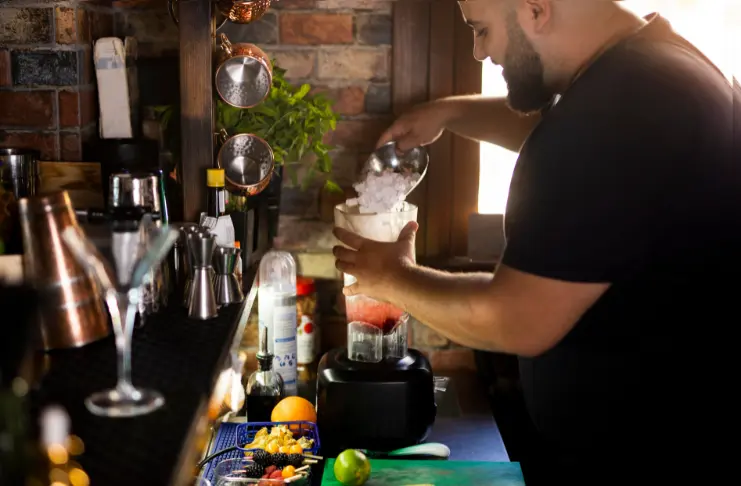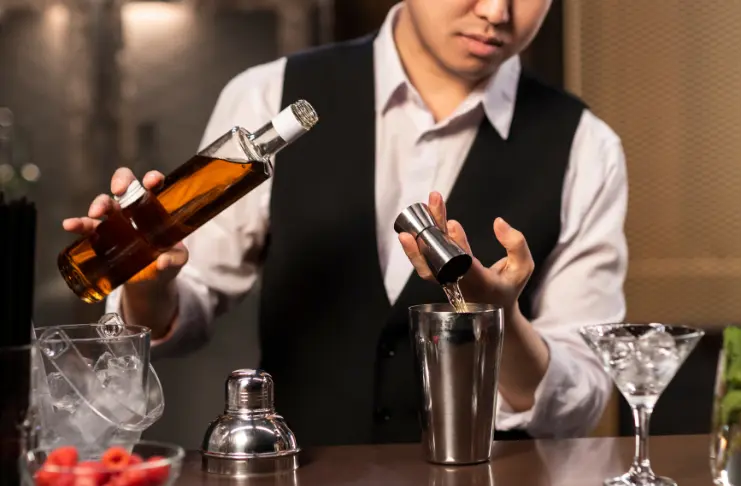
Liquor costs are one of the most significant controllable expenses for any bar or restaurant, often accounting for 20-25% of beverage revenue. Yet many operators struggle to keep these costs in check, losing thousands of dollars each month to overpouring, spillage, theft, or mismatched inventory. These losses are rarely obvious until financial reports highlight poor margins, making liquor cost control highly critical.
As a result, managing liquor costs starts with clarity. You need to know exactly how much each bottle contributes to revenue, where losses are happening, and how operational choices, like pour sizes or staff practices, affect your margins.
With a better idea of usage patterns, you can make informed decisions about pricing, portion sizes, menu design, and ordering practices. This guide will explore what liquor cost is, the ways it impacts profitability, and how to calculate and control liquor costs.
What are Liquor Costs?
Liquor cost is the total amount a bar or restaurant spends to serve alcoholic beverages, including both the purchase price of the drinks and any losses incurred during service. It represents how much revenue is being used to cover the cost of spirits, wine, beer, and mixers, and serves as a key measure of operational efficiency and profitability.
Liquor cost has two main components:
- Direct Costs: These are the straightforward expenses of purchasing alcoholic beverages, including bottles of spirits, wine, beer, and mixers. Every item on your bar’s shelves contributes directly to this figure, and fluctuations in wholesale prices can immediately affect your overall beverage cost.
- Indirect Costs: These are the less obvious but equally important costs, such as losses from spillage, theft, overpouring, and even broken bottles. While direct costs are easy to track through invoices, indirect costs require operational oversight, staff training, and monitoring systems to quantify and control.
How to Calculate Liquor Cost Percentage?

The liquor cost percentage expresses your expenses as a share of liquor sales. It’s a standard metric to gauge profitability and operational efficiency. The formula is:
Liquor Cost Percentage= [(Opening Inventory + Purchases – Closing Inventory)/ Sales] x 100
For example, suppose a bar starts the month with an opening inventory of $1,900, makes purchases of $5,300, ends with $2,200 in inventory, and records $25,000 in liquor sales.
Then, Liquor Cost Percentage = [(1900 + 5300 – 2200)/ 25000] x 100
= [5000/25000] x 100 = 20%
This percentage indicates that roughly one-fifth of the bar’s revenue is going toward covering liquor costs.
Most bars and restaurants aim for a liquor cost percentage between 18% and 24%, though the ideal range varies by establishment type. High-volume casual bars may operate closer to 20%, while upscale cocktail lounges may tolerate slightly higher percentages due to premium pricing.
These benchmarks can serve as a starting point to assess your bar or restaurant’s performance. However, it’s essential to consider these factors when determining your target liquor cost-
- Type of Establishment: Fine dining, casual bars, and nightclub lounges have different profit expectations and drink offerings, which affect acceptable liquor cost percentages.
- Location: Regional price differences for spirits and local competition can influence what’s realistic for your operation.
- Menu Offerings: Specialty cocktails or high-end spirits can justify higher liquor costs, while high-volume beers and house cocktails often require stricter cost control.
INDUSTRY INSIGHT
Most bars generate gross margins of around 70-85% on alcoholic beverages. This high profitability comes from the wide gap between the relatively low cost of goods (COGS) and the menu price customers are willing to pay, making drinks one of the most lucrative parts of restaurant sales.
How to Control Liquor Costs for Bars and Restaurants?
Once you understand what liquor costs comprise and how to calculate them, the next step is control. Reducing liquor expenses involves creating systems and processes that increase margins, minimize waste, and optimize every dollar spent behind the bar.
Here are some practical strategies that you can follow to manage your liquor costs better-
1. Set Par Levels
Par levels define how much of each liquor item should be on hand at any given time. By setting minimum and maximum stock levels, you ensure the bar never runs out of high-demand products while also avoiding overstocking that ties up capital or risks spoilage.
Determining par levels requires you to review past sales trends and adjust for seasonal fluctuations or special events.
For example, if a bar uses around 20 bottles of vodka per week, keeping 25 bottles on hand offers a buffer without creating unnecessary excess. Regularly reviewing and adjusting par levels keeps inventory aligned with demand and highlights unusual usage patterns that may indicate waste or theft.
2. Determine Target Pour Cost
Every drink has a target pour cost, which is the ideal ratio of ingredient cost to selling price. Tracking this metric ensures that each beverage contributes to profitability.
To determine your target pour cost, divide the cost of the liquor in the drink by the price at which it is sold, and multiply by 100 to get a percentage. For example, if a cocktail costs $2 in liquor and sells for $10, the pour cost is 20%.
It is important to establish clear targets so that you can better adjust pricing, portion sizes, and ingredient choices to maintain margins without sacrificing quality or customer satisfaction.
3. Set a Standard Pour Policy
Overpouring is one of the biggest contributors to high beverage costs. A standard pour policy ensures that every drink is made with the correct amount of liquor, keeping costs predictable and drinks consistent in quality.
Here, you can use tools like jiggers, measured pour spouts, or automated dispensers to make it easy for staff to follow set amounts. This will also bring consistency in the flavor profile and costs across every serving.
So, make sure to regularly communicate and reinforce these standards to better manage costs and simplify inventory tracking.
4. Implement a Zero-Tolerance Policy on Staff Theft
Unaccounted liquor is wasted money, and even small instances of theft can accumulate quickly. Establish a clear zero-tolerance policy that applies to all staff, combined with regular audits and accountability measures.
For this, track your inventory against sales weekly and investigate any discrepancies promptly. When employees know there is strict oversight and that theft has consequences, they are more likely to follow proper procedures.
5. Reduce Waste Through Proper Training
Spills, overpouring, and mistakes in drink preparation are avoidable but often overlooked sources of beverage cost. Investing time in staff training ensures everyone understands how to handle liquor, measure pours correctly, and assemble drinks efficiently.
At the same time, demonstrate the financial impact of waste to make the training tangible. Reinforcing proper habits through periodic refreshers and hands-on practice reduces losses significantly while improving overall service quality.

6. Manage Inventory
If you don’t know how your inventory performs, inefficiencies are bound to rise. Managing inventory does not just mean counting your stock, but understanding the sales patterns — what sells quickly, what doesn’t, and where losses occur.
If a bottle is disappearing faster than sales justify, it could point to overpouring, waste, or theft. Tracking inventory closely allows you to make smarter ordering decisions, avoid overstocking, and ensure cash flow isn’t tied up in bottles that aren’t moving.
Over time, it also highlights which products drive revenue and which items need attention, giving you a clearer picture of your operation’s efficiency.
7. Utilize Bulk Discounts
Buying in bulk can be a cost-saver, but it only works if you balance price with storage and usage. Focus on items you know move consistently, such as vodka, beer, or standard mixers, and negotiate volume discounts with suppliers.
However, align bulk purchases with par levels and expected demand to avoid overstocking products that sit on shelves. When done strategically, bulk buying helps reduce direct costs and makes budgeting more predictable, all while keeping inventory lean and manageable.
8. Monitor and Adjust Menu Pricing Regularly
Liquor costs are never static, and your pricing shouldn’t be either. Regularly review your menu and adjust prices based on ingredient costs and sales trends to keep healthy margins. For instance, if the price of a popular whiskey rises, you might need to adjust the price of cocktails containing it or tweak the recipe slightly.
The data from your POS system can help identify drinks with slim margins, highlighting opportunities to promote higher-margin offerings or refine recipes. Dynamic pricing ensures that your menu remains profitable without surprising customers, while also giving you flexibility to respond quickly to market or supplier changes.
9. Use Technology for Real-Time Tracking
Technology turns data into actionable insight. Modern POS and bar management systems track inventory, sales, and pour costs in real time, allowing you to spot issues immediately. For instance, these systems can flag unexpected consumption of a premium alcohol, letting you investigate overpouring or potential theft before it becomes a major loss.
Plus, analytics can reveal trends, such as which drinks are most profitable or which are more popular. By integrating technology into your operations, you reduce manual errors, save time, and gain precise control over liquor costs, making it easier to make informed decisions that directly impact your bottom line.
Key Metrics to Track for Liquor Cost Management

Tracking your alcohol costs is only valuable if you can interpret the data and understand what it means for your operation. Metrics turn raw numbers into actionable insights, and focusing on the right indicators is essential to make informed decisions and prioritize efforts that maximize profitability.
1. Pour Cost Per Drink
Pour cost per drink measures the cost of the liquor (raw material) in a single beverage relative to its selling price. Monitoring this metric helps you see how different drinks are contributing to your margins.
Also, compare the actual pour cost to your target and track trends weekly. For example, if a cocktail consistently exceeds its target, it may indicate overpouring or mispricing.
2. Cost Percentage by Category
Not all alcohol types have the same cost structure. Cost percentage by category measures the liquor cost for whiskey, vodka, tequila, beer, and wine separately, relative to their sales. This helps pinpoint categories where costs are higher than expected.
If premium alcohol consistently exceeds its target percentage, you can investigate instances of overpouring, pricing, or inventory issues specific to that category.
3. Sales vs. Inventory Variances
This metric compares the amount of liquor sold to what your inventory shows as used. Significant discrepancies between the two can signal potential waste, theft, or errors in recording.
Integrated POS and inventory systems can automate variance tracking, making it easier to spot unusual patterns, such as high usage of a particular item without corresponding sales.
4. Waste and Spillage Rate
Waste and spillage rate measures the percentage of inventory lost due to spills, overpouring, or breakage. The average spillage rate is around 1-2%, and anything higher than that indicates inefficiencies. Tracking this metric helps identify training gaps or operational issues that contribute to preventable losses.
Benefits of Controlling Liquor Costs

1. Maintains Profit Margins
Keeping liquor costs in check directly impacts your bottom line. Every ounce of alcohol overpoured or unaccounted for reduces profitability. By monitoring costs and ensuring consistent pours, you can improve margins on every drink sold, turning what might seem like small losses into measurable profit.
2. Improves Inventory Management
Effective cost control requires accurate tracking of stock levels and usage patterns. When you know what’s being used and where losses occur, you can order smarter, reduce overstocking, and prevent cash flow from being tied up in unused inventory. Better inventory management also makes it easier to forecast demand and avoid last-minute shortages.
3. Enhances Staff Accountability
Clear policies, standardized pouring levels, and performance metrics create accountability among staff. Employees understand how their actions affect costs and are more likely to follow established procedures. This reduces waste, minimizes theft, and promotes a culture of responsibility, which ultimately benefits both operations and profitability.
4. Enables Data-Driven Decisions
Controlling liquor costs provides reliable data that informs pricing, menu strategy, and purchasing decisions. Operators can identify high- and low-margin drinks, adjust recipes, or update pricing with confidence. Data-driven insights remove guesswork, allowing bars and restaurants to make strategic choices that boost revenue.
5. Supports Long-Term Sustainability
Consistent cost control reduces unnecessary waste, helps manage resources efficiently, and ensures that operations remain profitable over time. This level of control also allows businesses to scale responsibly, maintain predictable cash flow, and invest in growth opportunities without being undermined by uncontrolled liquor expenses.
Conclusion
Liquor cost management is a reflection of how well a bar or restaurant understands its own economics. And as guest preferences shift and operating costs continue to rise, the importance of effective cost control is only going to grow. The bars and restaurants that thrive will be the ones that build cost awareness into daily practice while staying flexible enough to adapt.
With accurate tracking, smart pricing, and a culture of accountability, your beverage program is positioned to evolve with the market and keep your business resilient for years to come.
Frequently Asked Questions
Controlling liquor cost involves tracking pour costs, setting standard pour policies, monitoring inventory, reducing waste, and training staff effectively. Using data-driven metrics like category cost percentages, sales-to-inventory variances, and KPIs allows bars and restaurants to identify inefficiencies and maintain profitable margins consistently.
Liquor pricing strategy should focus on maintaining cost, demand, and margin targets. Operators set prices based on target pour cost, ingredient quality, and customer expectations, often applying tiered pricing for high- and low-margin drinks. Regular menu reviews and adjustments help maintain profitability while staying competitive in the market.
The basic formula for liquor pricing is: Drink Price = Cost of Ingredients ÷ Target Pour Cost %. For example, if a cocktail costs $2 in liquor and your target pour cost is 20%, the selling price would be $10. This ensures margins align with business goals.
Saving money on liquor requires controlling portions, reducing waste, managing inventory efficiently, leveraging bulk purchasing, and negotiating supplier discounts. Monitoring costs, adjusting menu pricing, and using technology to track real-time usage help operators minimize unnecessary losses and improve overall profitability.








